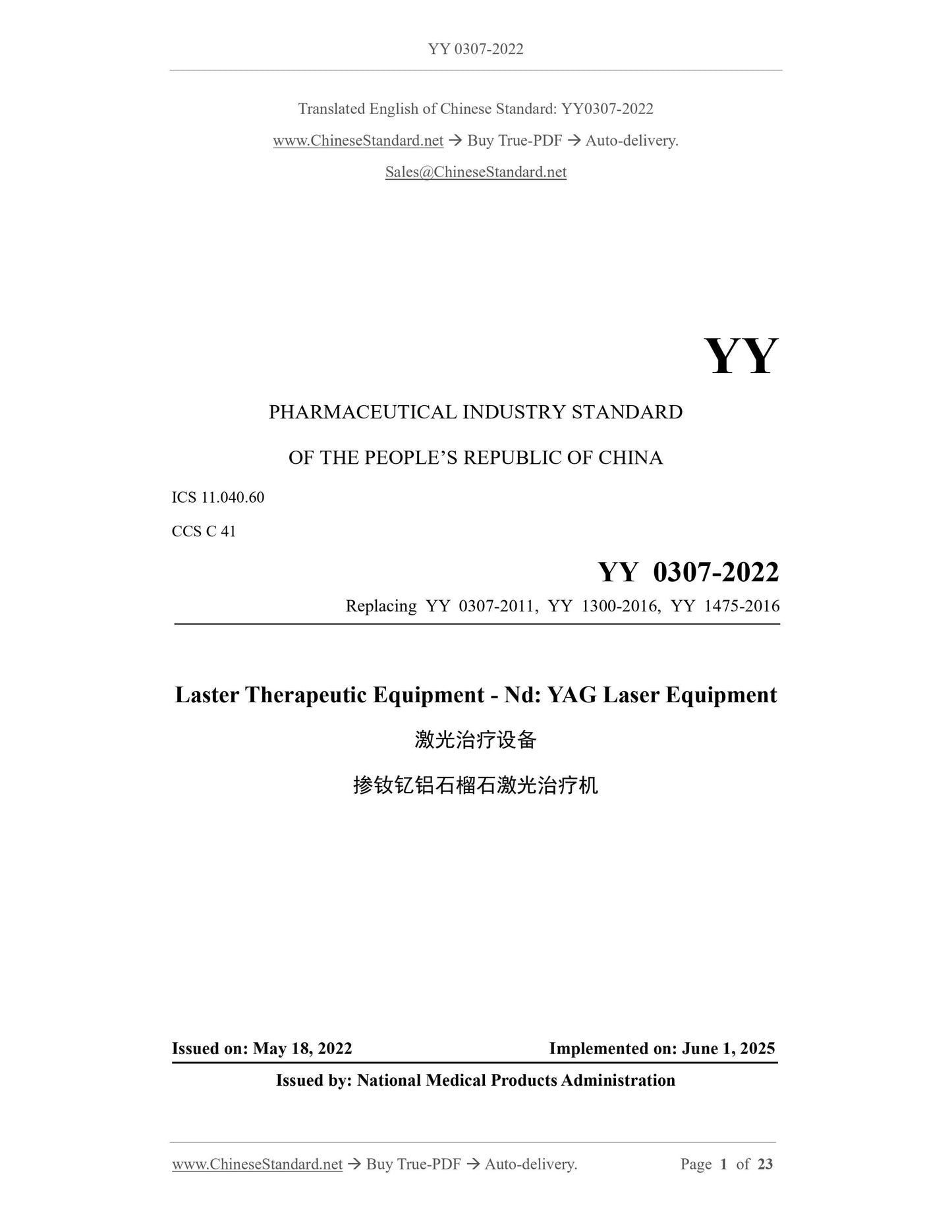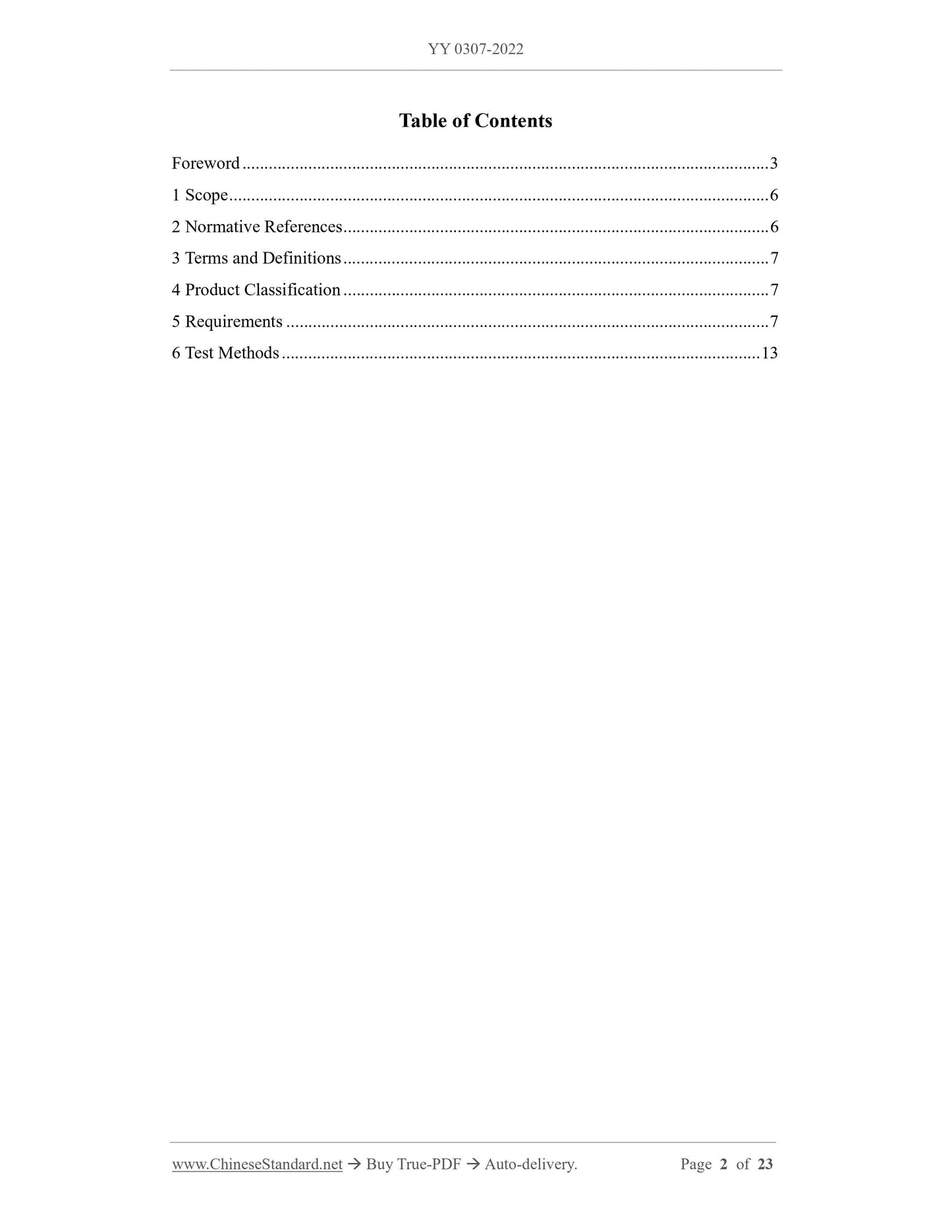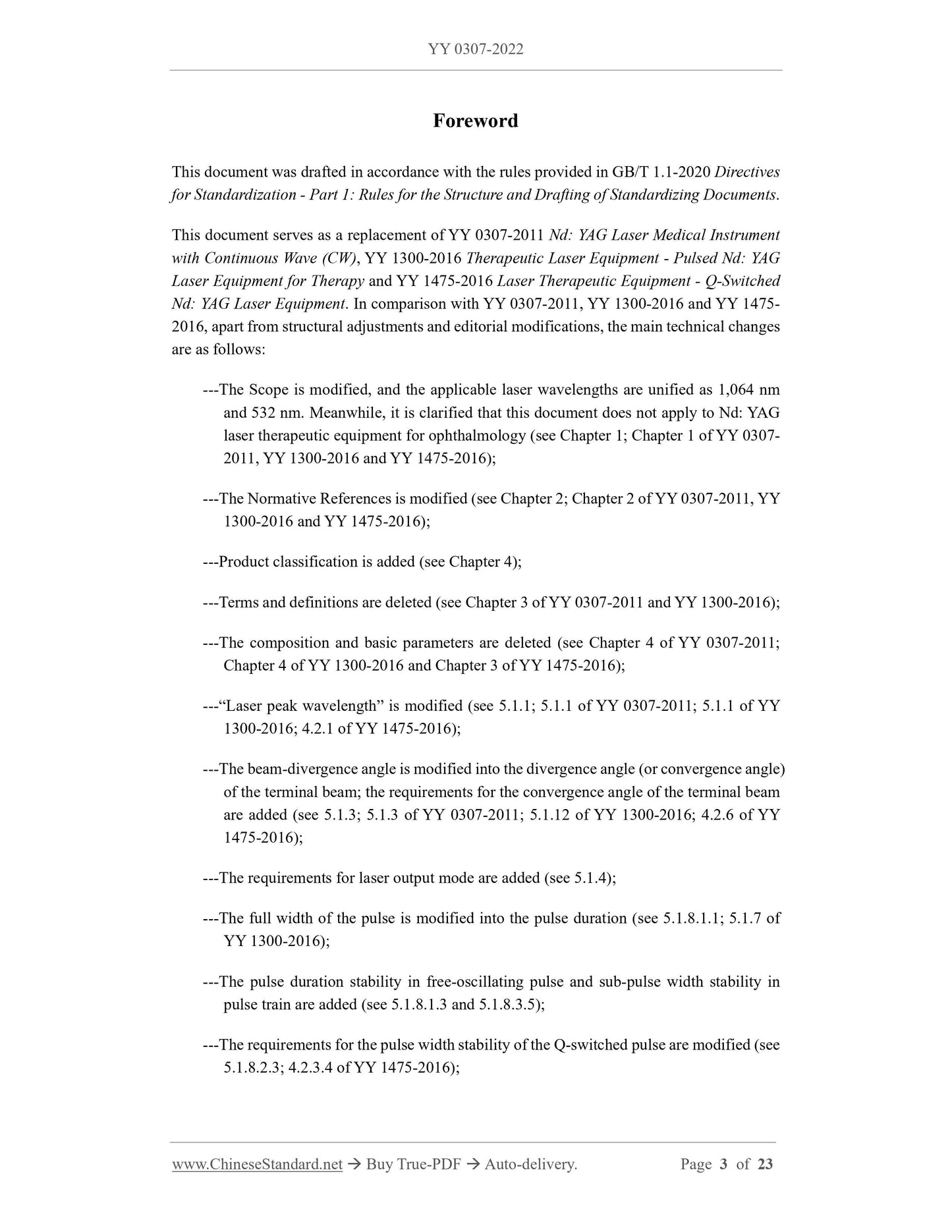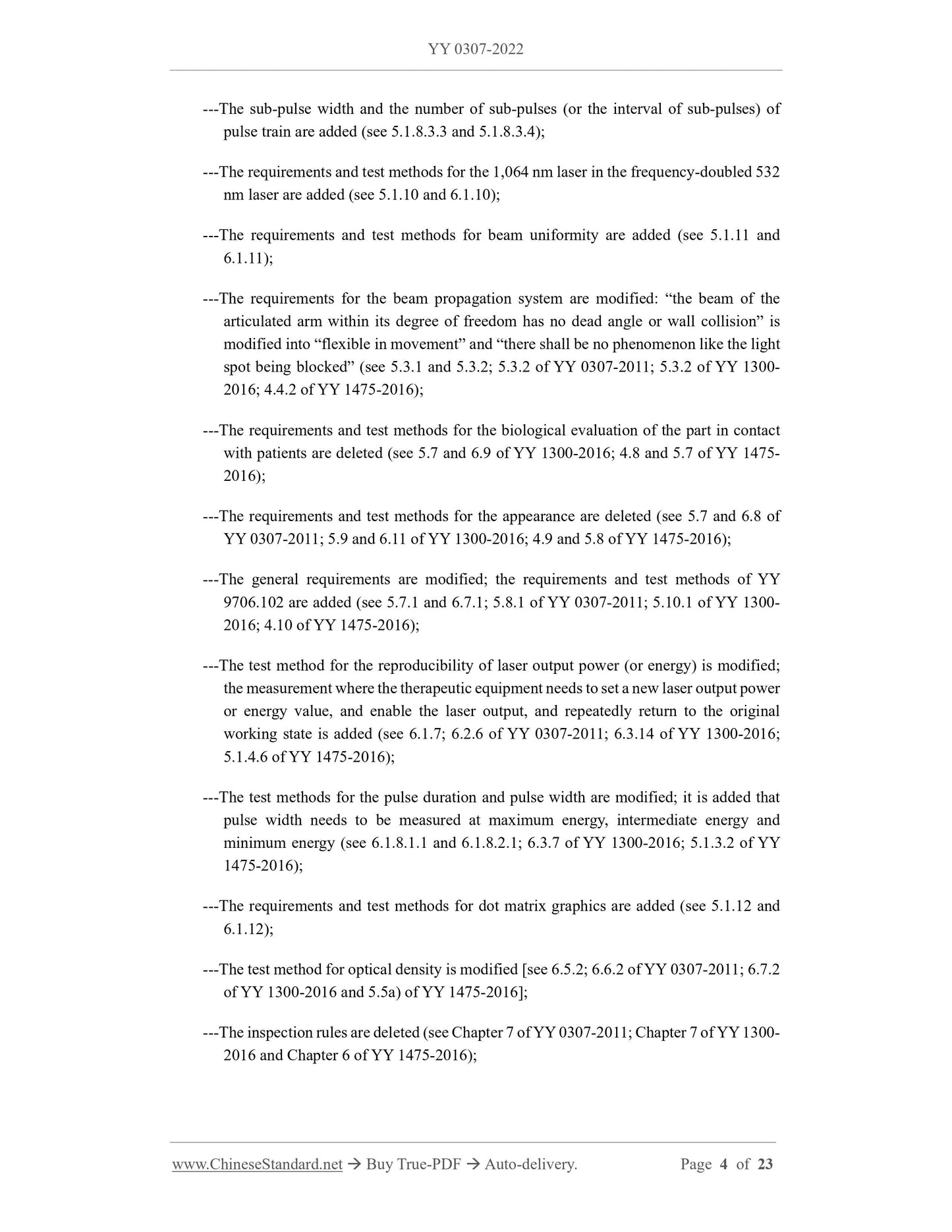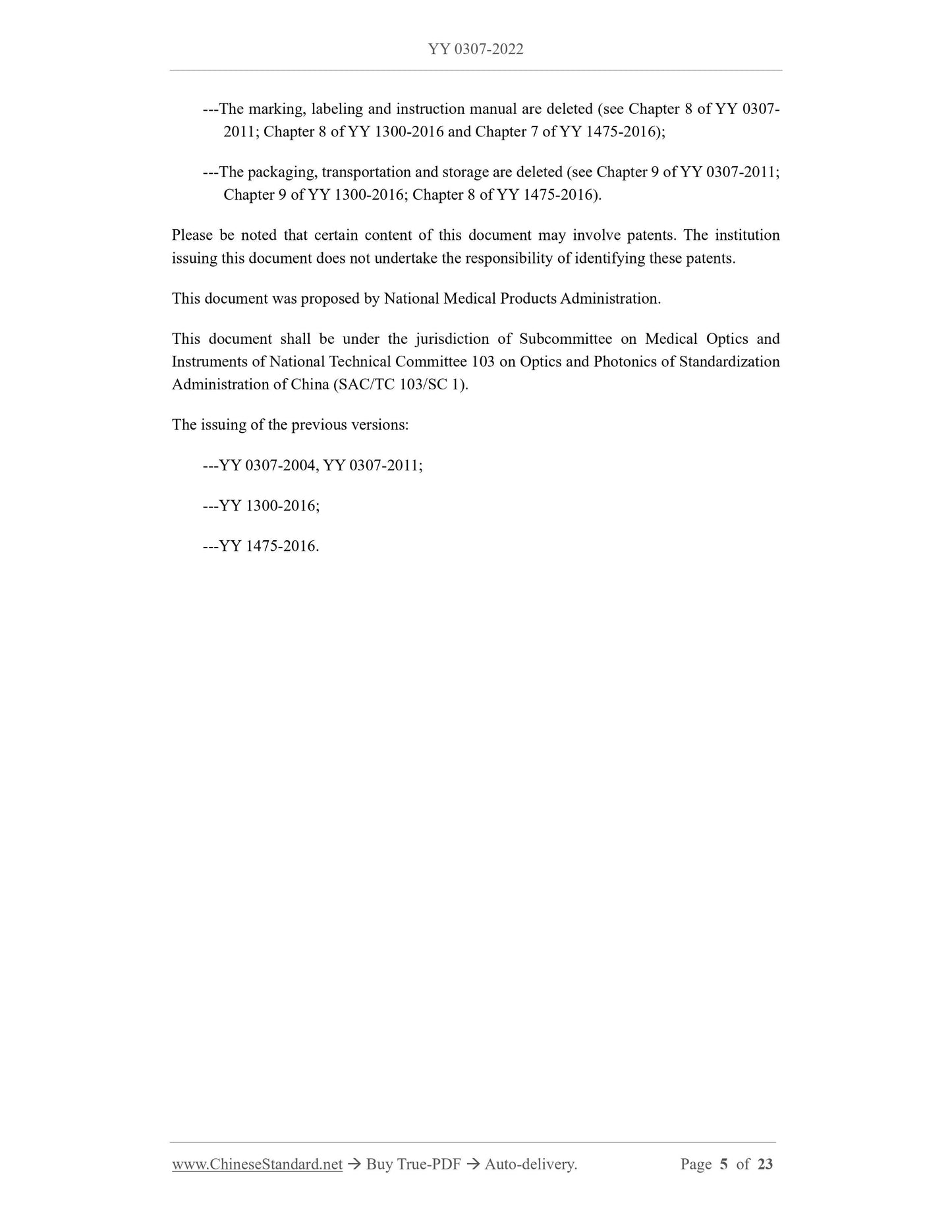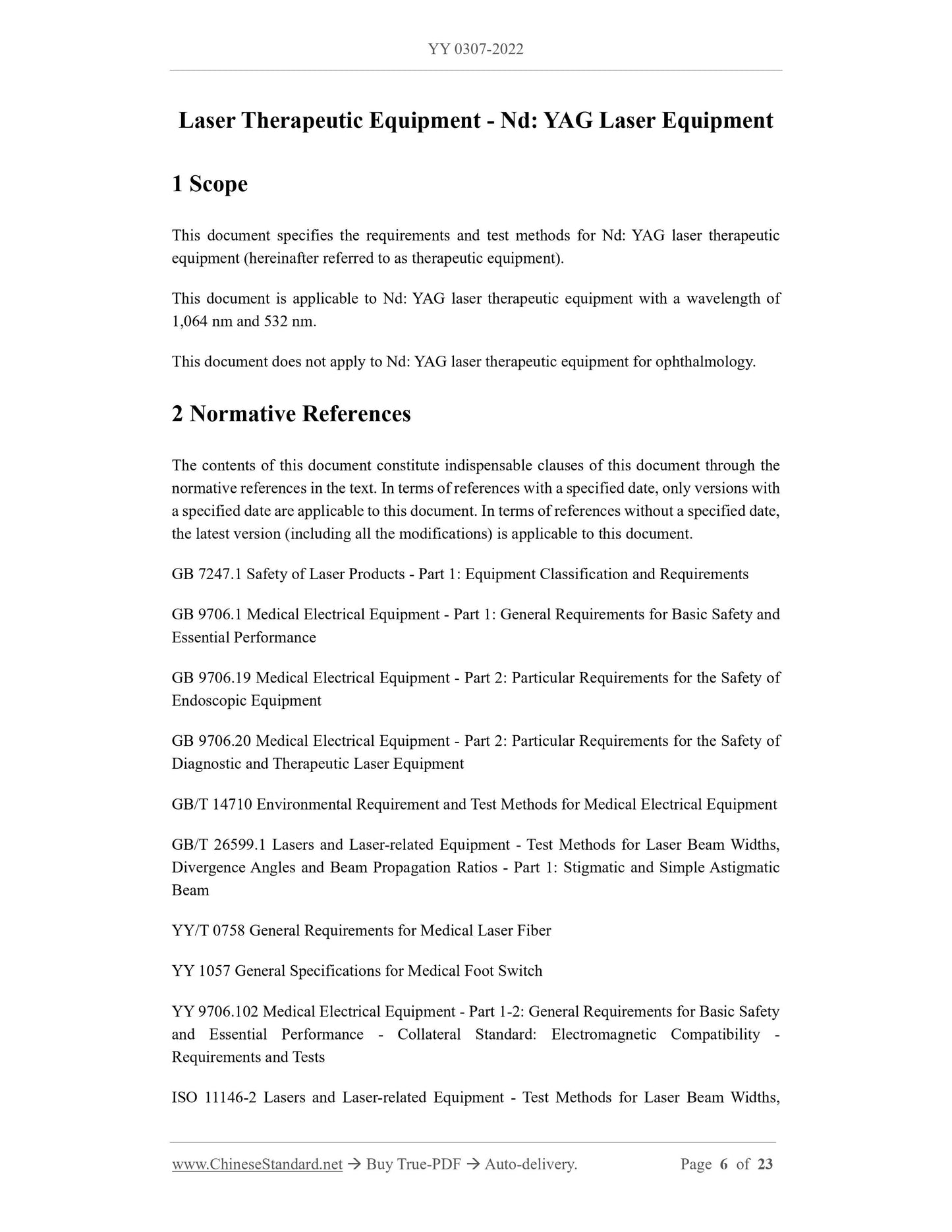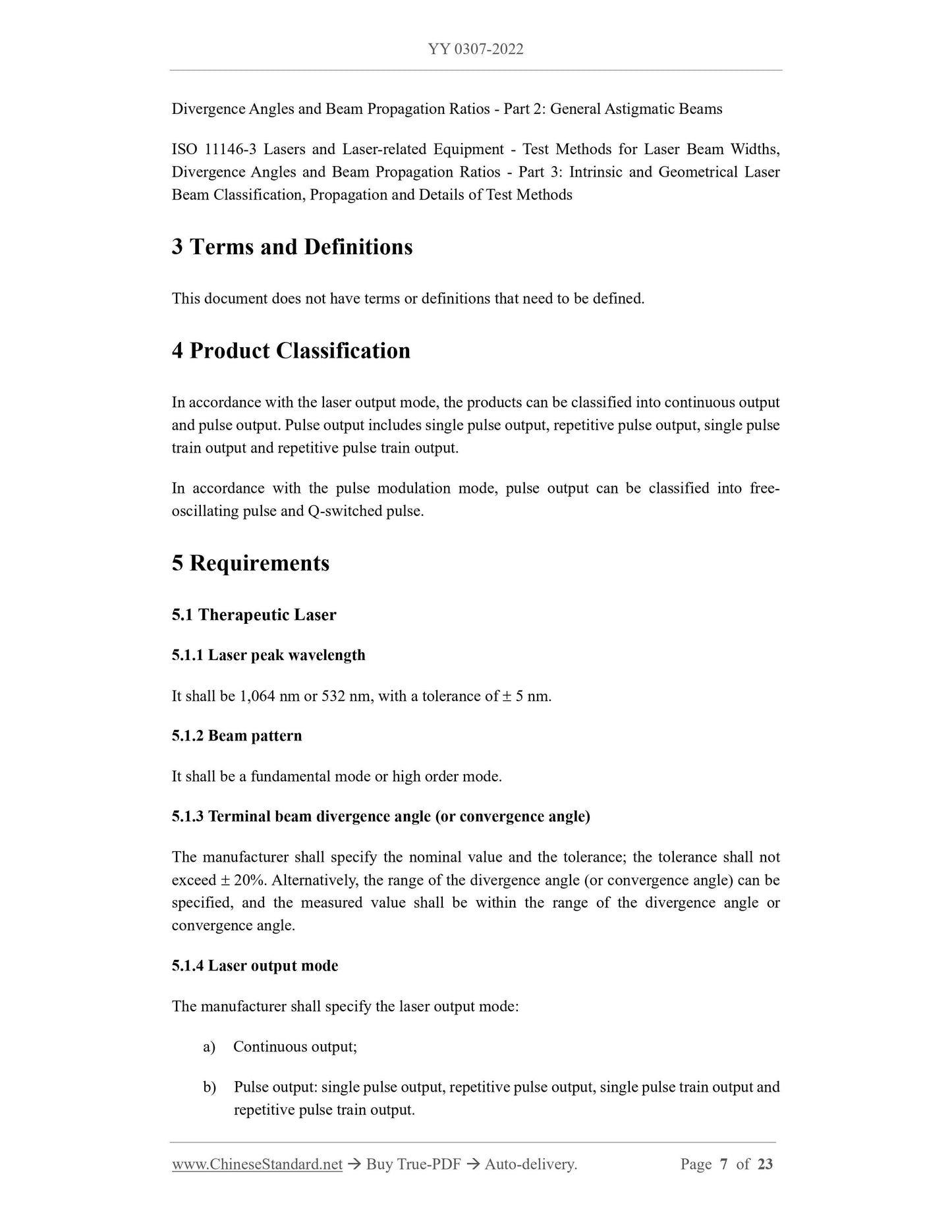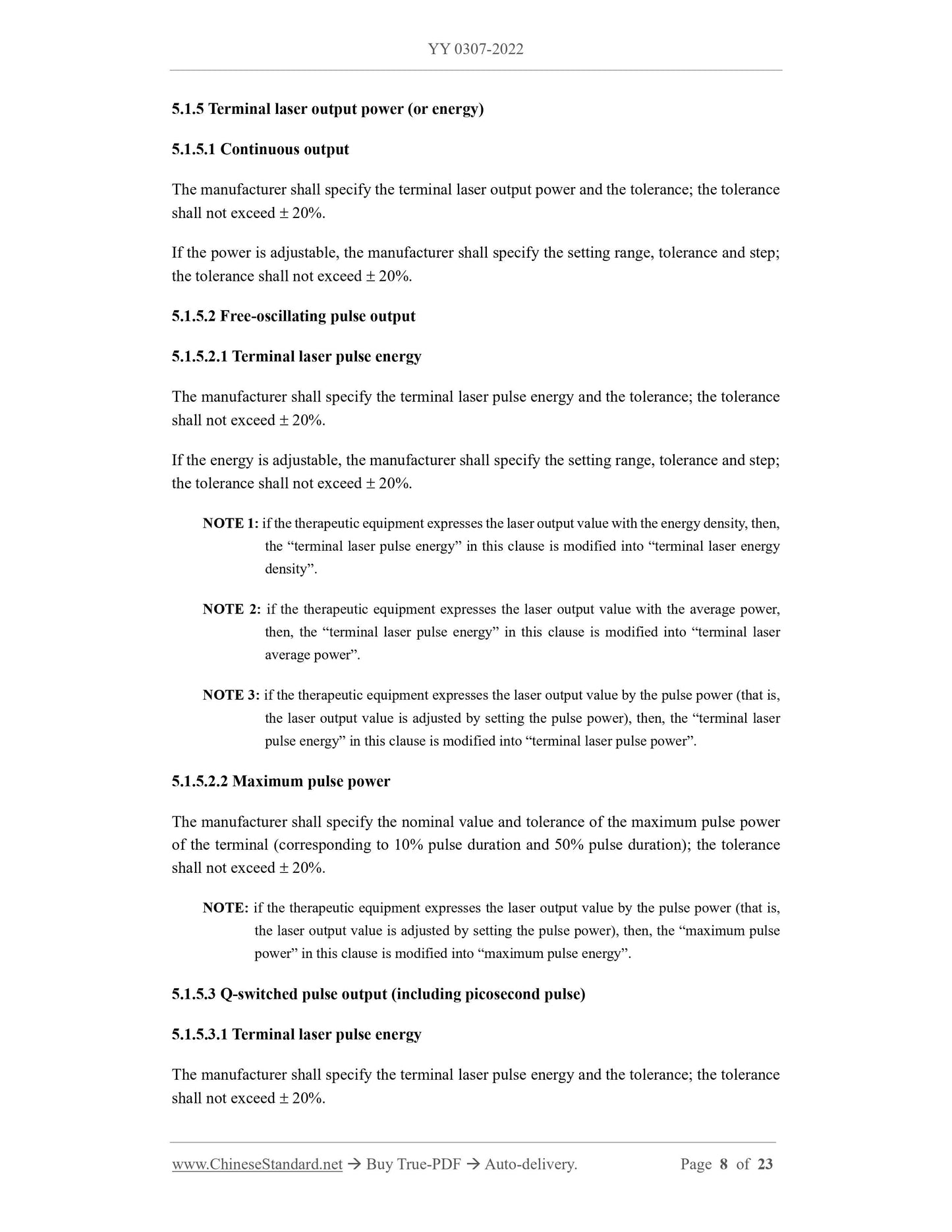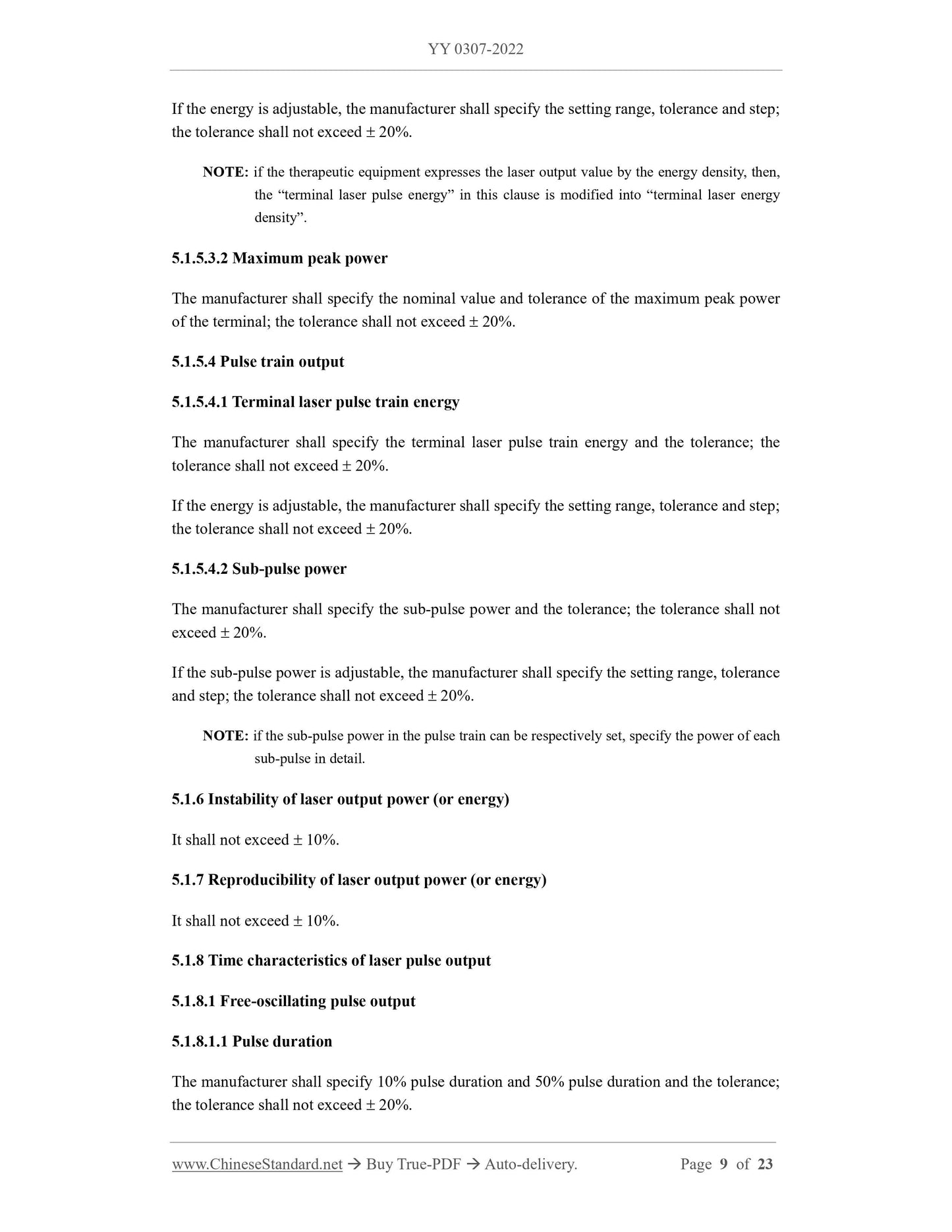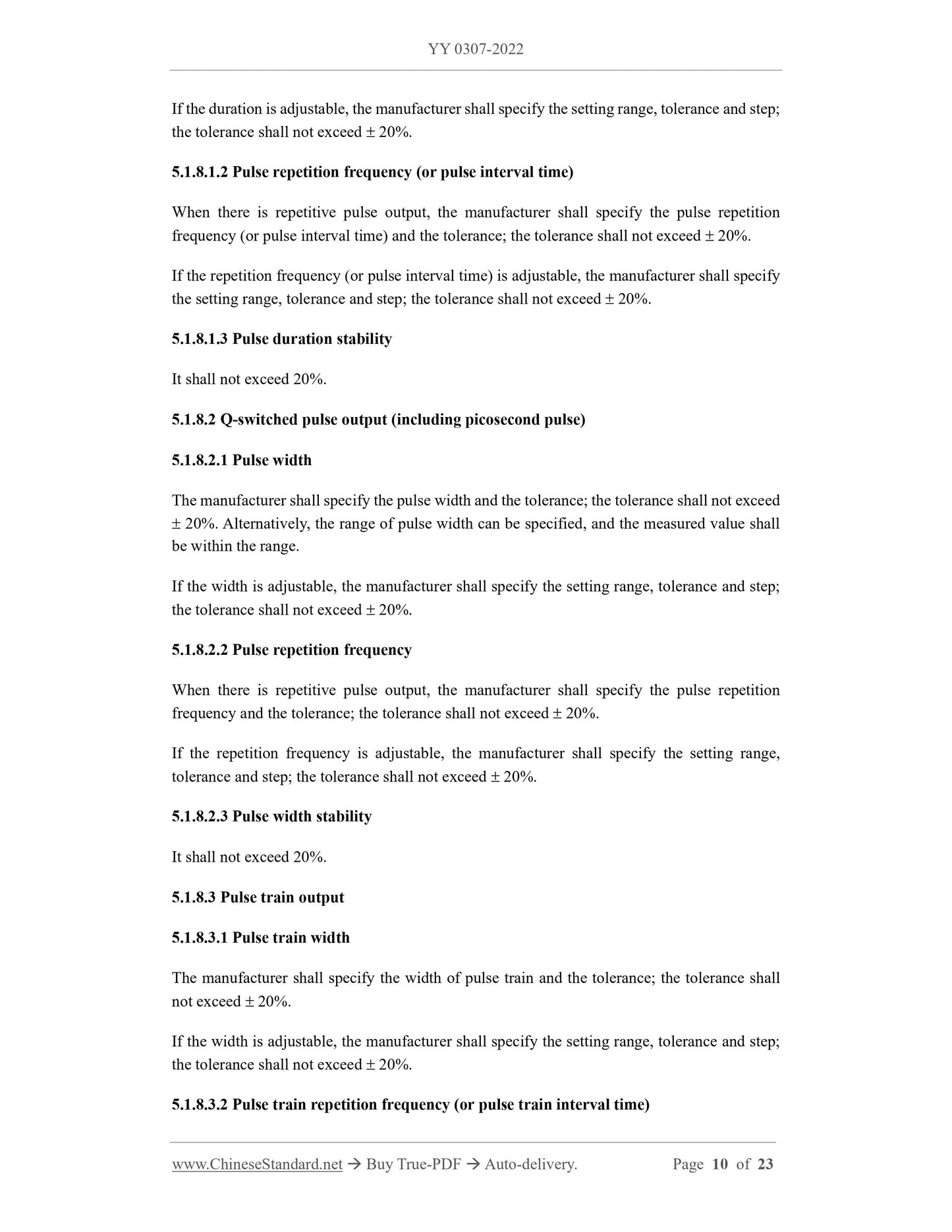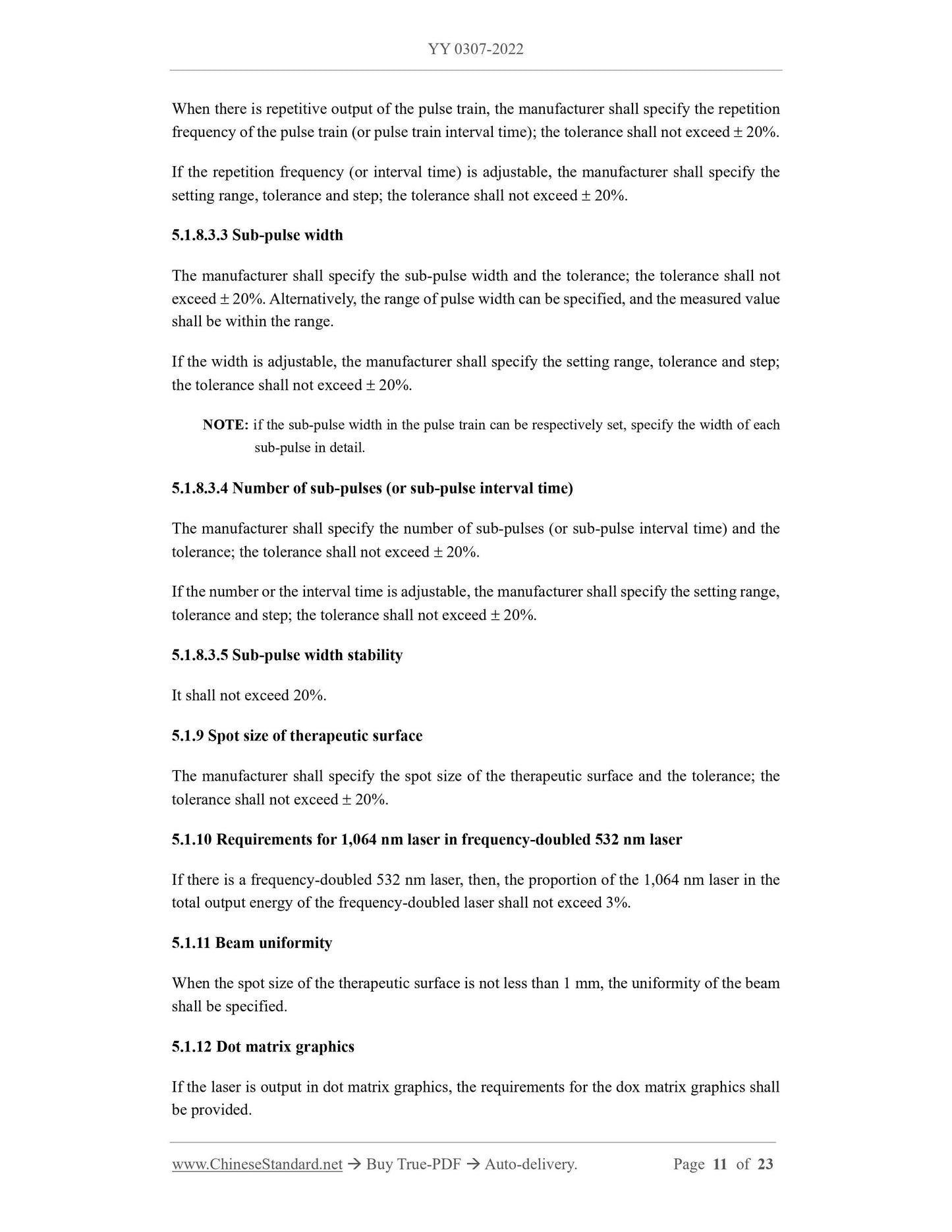1
/
of
11
PayPal, credit cards. Download editable-PDF and invoice in 1 second!
YY 0307-2022 English PDF (YY0307-2022)
YY 0307-2022 English PDF (YY0307-2022)
Regular price
$260.00 USD
Regular price
Sale price
$260.00 USD
Unit price
/
per
Shipping calculated at checkout.
Couldn't load pickup availability
Delivery: 3 seconds. Download true-PDF + Invoice.
Get QUOTATION in 1-minute: Click YY 0307-2022
Historical versions: YY 0307-2022
Preview True-PDF (Reload/Scroll if blank)
YY 0307-2022: Laser therapeutic equipment - Nd: YAG Laser Equipment
YY 0307-2022
YY
PHARMACEUTICAL INDUSTRY STANDARD
OF THE PEOPLE’S REPUBLIC OF CHINA
ICS 11.040.60
CCS C 41
Replacing YY 0307-2011, YY 1300-2016, YY 1475-2016
Laster Therapeutic Equipment - Nd: YAG Laser Equipment
激光治疗设备
ISSUED ON: MAY 18, 2022
IMPLEMENTED ON: JUNE 1, 2025
Issued by: National Medical Products Administration
Table of Contents
Foreword ... 3
1 Scope ... 6
2 Normative References ... 6
3 Terms and Definitions ... 7
4 Product Classification ... 7
5 Requirements ... 7
6 Test Methods ... 13
Laser Therapeutic Equipment - Nd: YAG Laser Equipment
1 Scope
This document specifies the requirements and test methods for Nd: YAG laser therapeutic
equipment (hereinafter referred to as therapeutic equipment).
This document is applicable to Nd: YAG laser therapeutic equipment with a wavelength of
1,064 nm and 532 nm.
This document does not apply to Nd: YAG laser therapeutic equipment for ophthalmology.
2 Normative References
The contents of this document constitute indispensable clauses of this document through the
normative references in the text. In terms of references with a specified date, only versions with
a specified date are applicable to this document. In terms of references without a specified date,
the latest version (including all the modifications) is applicable to this document.
GB 7247.1 Safety of Laser Products - Part 1: Equipment Classification and Requirements
GB 9706.1 Medical Electrical Equipment - Part 1: General Requirements for Basic Safety and
Essential Performance
GB 9706.19 Medical Electrical Equipment - Part 2: Particular Requirements for the Safety of
Endoscopic Equipment
GB 9706.20 Medical Electrical Equipment - Part 2: Particular Requirements for the Safety of
Diagnostic and Therapeutic Laser Equipment
GB/T 14710 Environmental Requirement and Test Methods for Medical Electrical Equipment
GB/T 26599.1 Lasers and Laser-related Equipment - Test Methods for Laser Beam Widths,
Divergence Angles and Beam Propagation Ratios - Part 1: Stigmatic and Simple Astigmatic
Beam
YY/T 0758 General Requirements for Medical Laser Fiber
YY 1057 General Specifications for Medical Foot Switch
YY 9706.102 Medical Electrical Equipment - Part 1-2: General Requirements for Basic Safety
and Essential Performance - Collateral Standard: Electromagnetic Compatibility -
Requirements and Tests
ISO 11146-2 Lasers and Laser-related Equipment - Test Methods for Laser Beam Widths,
5.1.5 Terminal laser output power (or energy)
5.1.5.1 Continuous output
The manufacturer shall specify the terminal laser output power and the tolerance; the tolerance
shall not exceed 20%.
If the power is adjustable, the manufacturer shall specify the setting range, tolerance and step;
the tolerance shall not exceed 20%.
5.1.5.2 Free-oscillating pulse output
5.1.5.2.1 Terminal laser pulse energy
The manufacturer shall specify the terminal laser pulse energy and the tolerance; the tolerance
shall not exceed 20%.
If the energy is adjustable, the manufacturer shall specify the setting range, tolerance and step;
the tolerance shall not exceed 20%.
NOTE 1: if the therapeutic equipment expresses the laser output value with the energy density, then,
the “terminal laser pulse energy” in this clause is modified into “terminal laser energy
density”.
NOTE 2: if the therapeutic equipment expresses the laser output value with the average power,
then, the “terminal laser pulse energy” in this clause is modified into “terminal laser
average power”.
NOTE 3: if the therapeutic equipment expresses the laser output value by the pulse power (that is,
the laser output value is adjusted by setting the pulse power), then, the “terminal laser
pulse energy” in this clause is modified into “terminal laser pulse power”.
5.1.5.2.2 Maximum pulse power
The manufacturer shall specify the nominal value and tolerance of the maximum pulse power
of the terminal (corresponding to 10% pulse duration and 50% pulse duration); the tolerance
shall not exceed 20%.
NOTE: if the therapeutic equipment expresses the laser output value by the pulse power (that is,
the laser output value is adjusted by setting the pulse power), then, the “maximum pulse
power” in this clause is modified into “maximum pulse energy”.
5.1.5.3 Q-switched pulse output (including picosecond pulse)
5.1.5.3.1 Terminal laser pulse energy
The manufacturer shall specify the terminal laser pulse energy and the tolerance; the tolerance
shall not exceed 20%.
If the energy is adjustable, the manufacturer shall specify the setting range, tolerance and step;
the tolerance shall not exceed 20%.
NOTE: if the therapeutic equipment expresses the laser output value by the energy density, then,
the “terminal laser pulse energy” in this clause is modified into “terminal laser energy
density”.
5.1.5.3.2 Maximum peak power
The manufacturer shall specify the nominal value and tolerance of the maximum peak power
of the terminal; the tolerance shall not exceed 20%.
5.1.5.4 Pulse train output
5.1.5.4.1 Terminal laser pulse train energy
The manufacturer shall specify the terminal laser pulse train energy and the tolerance; the
tolerance shall not exceed 20%.
If the energy is adjustable, the manufacturer shall specify the setting range, tolerance and step;
the tolerance shall not exceed 20%.
5.1.5.4.2 Sub-pulse power
The manufacturer shall specify the sub-pulse power and the tolerance; the tolerance shall not
exceed 20%.
If the sub-pulse power is adjustable, the manufacturer shall specify the setting range, tolerance
and step; the tolerance shall not exceed 20%.
NOTE: if the sub-pulse power in the pulse train can be respectively set, specify the power of each
sub-pulse in detail.
5.1.6 Instability of laser output power (or energy)
It shall not exceed 10%.
5.1.7 Reproducibility of laser output power (or energy)
It shall not exceed 10%.
5.1.8 Time characteristics of laser pulse output
5.1.8.1 Free-oscillating pulse output
5.1.8.1.1 Pulse duration
The manufacturer shall specify 10% pulse duration and 50% pulse duration and the tolerance;
the tolerance shall not exceed 20%.
When there is repetitive output of the pulse train, the manufacturer shall specify the repetition
frequency of the pulse train (or pulse train interval time); the tolerance shall not exceed 20%.
If the repetition frequency (or interval time) is adjustable, the manufacturer shall specify the
setting range, tolerance and step; the tolerance shall not exceed 20%.
5.1.8.3.3 Sub-pulse width
The manufacturer shall specify the sub-pulse width and the tolerance; the tolerance shall not
exceed 20%. Alternatively, the range of pulse width can be specified, and the measured value
shall be within the range.
If the width is adjustable, the manufacturer shall specify the setting range, tolerance and step;
the tolerance shall not exceed 20%.
NOTE: if the sub-pulse width in the pulse train can be respectively set, specify the width of each
sub-pulse in detail.
5.1.8.3.4 Number of sub-pulses (or sub-pulse interval time)
The manufacturer shall specify the number of sub-pulses (or sub-pulse interval time) and the
tolerance; the tolerance shall not exceed 20%.
If the number or the interval time is adjustable, the manufacturer shall specify the setting range,
tolerance and step; the tolerance shall not exceed 20%.
5.1.8.3.5 Sub-pulse width stability
It shall...
Get QUOTATION in 1-minute: Click YY 0307-2022
Historical versions: YY 0307-2022
Preview True-PDF (Reload/Scroll if blank)
YY 0307-2022: Laser therapeutic equipment - Nd: YAG Laser Equipment
YY 0307-2022
YY
PHARMACEUTICAL INDUSTRY STANDARD
OF THE PEOPLE’S REPUBLIC OF CHINA
ICS 11.040.60
CCS C 41
Replacing YY 0307-2011, YY 1300-2016, YY 1475-2016
Laster Therapeutic Equipment - Nd: YAG Laser Equipment
激光治疗设备
ISSUED ON: MAY 18, 2022
IMPLEMENTED ON: JUNE 1, 2025
Issued by: National Medical Products Administration
Table of Contents
Foreword ... 3
1 Scope ... 6
2 Normative References ... 6
3 Terms and Definitions ... 7
4 Product Classification ... 7
5 Requirements ... 7
6 Test Methods ... 13
Laser Therapeutic Equipment - Nd: YAG Laser Equipment
1 Scope
This document specifies the requirements and test methods for Nd: YAG laser therapeutic
equipment (hereinafter referred to as therapeutic equipment).
This document is applicable to Nd: YAG laser therapeutic equipment with a wavelength of
1,064 nm and 532 nm.
This document does not apply to Nd: YAG laser therapeutic equipment for ophthalmology.
2 Normative References
The contents of this document constitute indispensable clauses of this document through the
normative references in the text. In terms of references with a specified date, only versions with
a specified date are applicable to this document. In terms of references without a specified date,
the latest version (including all the modifications) is applicable to this document.
GB 7247.1 Safety of Laser Products - Part 1: Equipment Classification and Requirements
GB 9706.1 Medical Electrical Equipment - Part 1: General Requirements for Basic Safety and
Essential Performance
GB 9706.19 Medical Electrical Equipment - Part 2: Particular Requirements for the Safety of
Endoscopic Equipment
GB 9706.20 Medical Electrical Equipment - Part 2: Particular Requirements for the Safety of
Diagnostic and Therapeutic Laser Equipment
GB/T 14710 Environmental Requirement and Test Methods for Medical Electrical Equipment
GB/T 26599.1 Lasers and Laser-related Equipment - Test Methods for Laser Beam Widths,
Divergence Angles and Beam Propagation Ratios - Part 1: Stigmatic and Simple Astigmatic
Beam
YY/T 0758 General Requirements for Medical Laser Fiber
YY 1057 General Specifications for Medical Foot Switch
YY 9706.102 Medical Electrical Equipment - Part 1-2: General Requirements for Basic Safety
and Essential Performance - Collateral Standard: Electromagnetic Compatibility -
Requirements and Tests
ISO 11146-2 Lasers and Laser-related Equipment - Test Methods for Laser Beam Widths,
5.1.5 Terminal laser output power (or energy)
5.1.5.1 Continuous output
The manufacturer shall specify the terminal laser output power and the tolerance; the tolerance
shall not exceed 20%.
If the power is adjustable, the manufacturer shall specify the setting range, tolerance and step;
the tolerance shall not exceed 20%.
5.1.5.2 Free-oscillating pulse output
5.1.5.2.1 Terminal laser pulse energy
The manufacturer shall specify the terminal laser pulse energy and the tolerance; the tolerance
shall not exceed 20%.
If the energy is adjustable, the manufacturer shall specify the setting range, tolerance and step;
the tolerance shall not exceed 20%.
NOTE 1: if the therapeutic equipment expresses the laser output value with the energy density, then,
the “terminal laser pulse energy” in this clause is modified into “terminal laser energy
density”.
NOTE 2: if the therapeutic equipment expresses the laser output value with the average power,
then, the “terminal laser pulse energy” in this clause is modified into “terminal laser
average power”.
NOTE 3: if the therapeutic equipment expresses the laser output value by the pulse power (that is,
the laser output value is adjusted by setting the pulse power), then, the “terminal laser
pulse energy” in this clause is modified into “terminal laser pulse power”.
5.1.5.2.2 Maximum pulse power
The manufacturer shall specify the nominal value and tolerance of the maximum pulse power
of the terminal (corresponding to 10% pulse duration and 50% pulse duration); the tolerance
shall not exceed 20%.
NOTE: if the therapeutic equipment expresses the laser output value by the pulse power (that is,
the laser output value is adjusted by setting the pulse power), then, the “maximum pulse
power” in this clause is modified into “maximum pulse energy”.
5.1.5.3 Q-switched pulse output (including picosecond pulse)
5.1.5.3.1 Terminal laser pulse energy
The manufacturer shall specify the terminal laser pulse energy and the tolerance; the tolerance
shall not exceed 20%.
If the energy is adjustable, the manufacturer shall specify the setting range, tolerance and step;
the tolerance shall not exceed 20%.
NOTE: if the therapeutic equipment expresses the laser output value by the energy density, then,
the “terminal laser pulse energy” in this clause is modified into “terminal laser energy
density”.
5.1.5.3.2 Maximum peak power
The manufacturer shall specify the nominal value and tolerance of the maximum peak power
of the terminal; the tolerance shall not exceed 20%.
5.1.5.4 Pulse train output
5.1.5.4.1 Terminal laser pulse train energy
The manufacturer shall specify the terminal laser pulse train energy and the tolerance; the
tolerance shall not exceed 20%.
If the energy is adjustable, the manufacturer shall specify the setting range, tolerance and step;
the tolerance shall not exceed 20%.
5.1.5.4.2 Sub-pulse power
The manufacturer shall specify the sub-pulse power and the tolerance; the tolerance shall not
exceed 20%.
If the sub-pulse power is adjustable, the manufacturer shall specify the setting range, tolerance
and step; the tolerance shall not exceed 20%.
NOTE: if the sub-pulse power in the pulse train can be respectively set, specify the power of each
sub-pulse in detail.
5.1.6 Instability of laser output power (or energy)
It shall not exceed 10%.
5.1.7 Reproducibility of laser output power (or energy)
It shall not exceed 10%.
5.1.8 Time characteristics of laser pulse output
5.1.8.1 Free-oscillating pulse output
5.1.8.1.1 Pulse duration
The manufacturer shall specify 10% pulse duration and 50% pulse duration and the tolerance;
the tolerance shall not exceed 20%.
When there is repetitive output of the pulse train, the manufacturer shall specify the repetition
frequency of the pulse train (or pulse train interval time); the tolerance shall not exceed 20%.
If the repetition frequency (or interval time) is adjustable, the manufacturer shall specify the
setting range, tolerance and step; the tolerance shall not exceed 20%.
5.1.8.3.3 Sub-pulse width
The manufacturer shall specify the sub-pulse width and the tolerance; the tolerance shall not
exceed 20%. Alternatively, the range of pulse width can be specified, and the measured value
shall be within the range.
If the width is adjustable, the manufacturer shall specify the setting range, tolerance and step;
the tolerance shall not exceed 20%.
NOTE: if the sub-pulse width in the pulse train can be respectively set, specify the width of each
sub-pulse in detail.
5.1.8.3.4 Number of sub-pulses (or sub-pulse interval time)
The manufacturer shall specify the number of sub-pulses (or sub-pulse interval time) and the
tolerance; the tolerance shall not exceed 20%.
If the number or the interval time is adjustable, the manufacturer shall specify the setting range,
tolerance and step; the tolerance shall not exceed 20%.
5.1.8.3.5 Sub-pulse width stability
It shall...
Share
